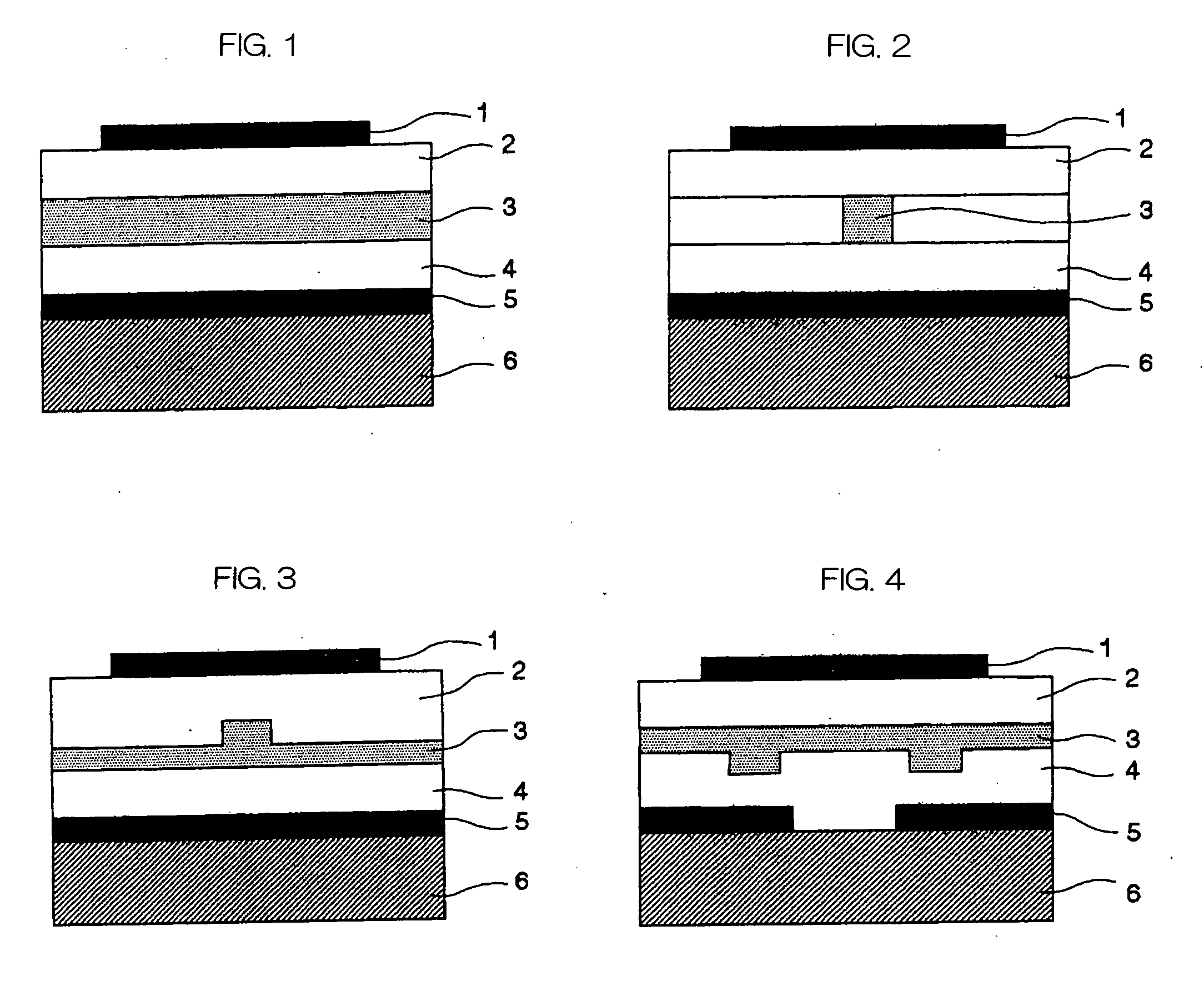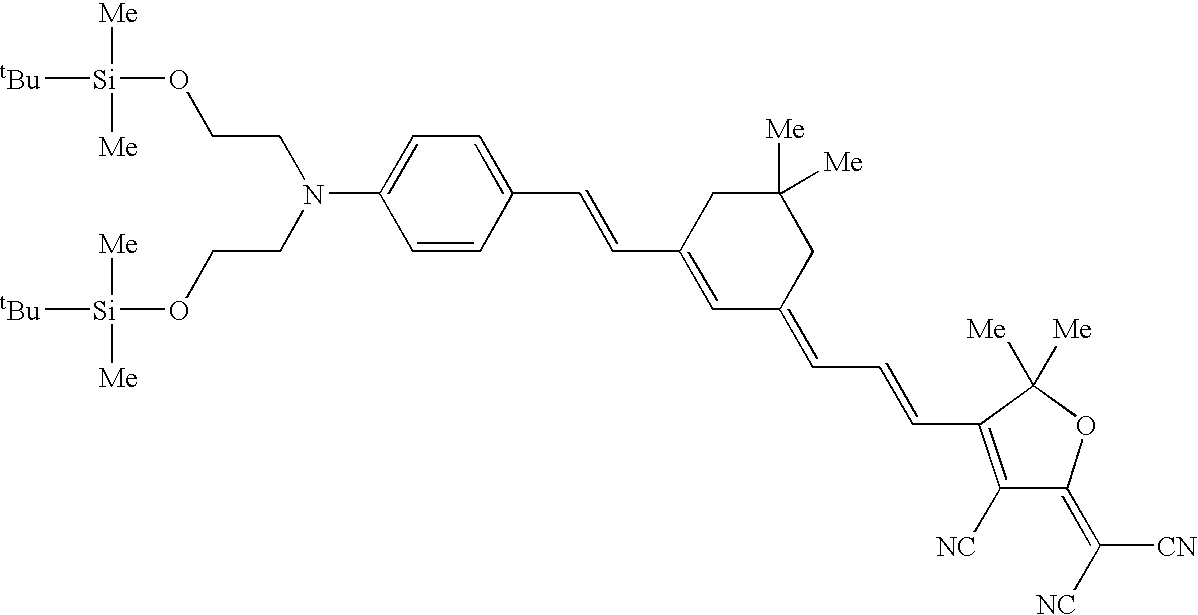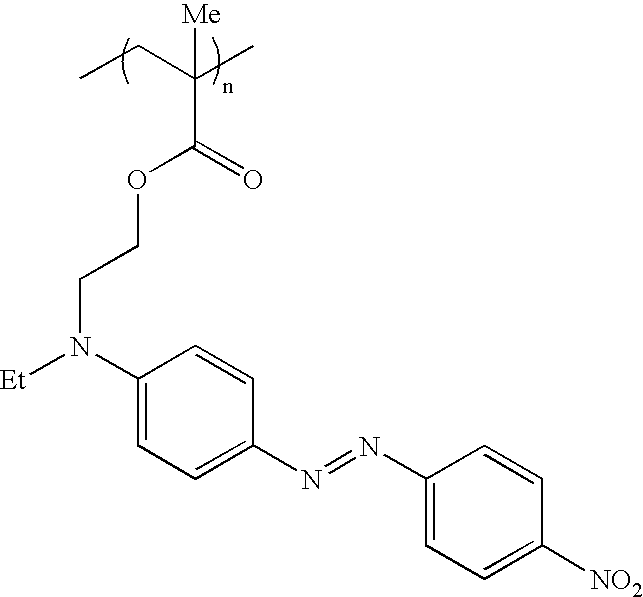Stock solution for production of nonlinear-optical materials, nonlinear-optical material, and nonlinear-optical device
a nonlinear optical and stock solution technology, applied in the field of nonlinear optical materials and nonlinear optical materials, can solve the problems of difficult to produce the large organic crystals required for producing optical devices, difficult to control crystal structure artificially, and rare crystal structure without symmetry center, etc., to achieve the effect of increasing the refractive index of the resulting optical materials, promoting the hydrolysis of the hydrolysable silyl groups, and too high reactivity
- Summary
- Abstract
- Description
- Claims
- Application Information
AI Technical Summary
Benefits of technology
Problems solved by technology
Method used
Image
Examples
example 1
Preparation of Stock Solution A
[0181] To a solution wherein the composition below is mixed and dissolved well, 0.6 part by mass of an ion exchange resin (AMBERLYST® 15E, manufactured by Rohm and Haas Company) is added as a solid catalyst. The slurry is stirred and reacted (hydrolysis treatment) at room temperature for one hour and filtered through a membrane filter to remove the ion exchange resin (catalyst-separation treatment). To the solution, 0.06 part by mass of aluminum trisacetylacetonate and 0.06 part by mass of acetylacetone are added respectively as a heat-curing catalyst and a curing inhibitor, to give a stock solution A for production of nonlinear-optical materials. [0182] Nonlinear-optically active organic compound having two hydrolysable silyl groups represented by Structural Formula (1-1): 1 part by mass [0183] Distilled water: 0.2 part by mass [0184] Methanol: 1 part by mass [0185] Tetrahydrofuran: 4 parts by mass [0186] Cyclohexanone: 18 parts by mass
[0187] The ...
example 2
Preparation of Stock Solution B
[0196] To a solution wherein the composition below is mixed and dissolved well, 0.6 part by mass of an ion exchange resin (AMBERLYST® 15E, manufactured by Rohm and Haas Company) is added as a solid catalyst. The slurry is stirred and reacted at room temperature for one hour (hydrolysis treatment), and filtered through a membrane filter to remove the ion exchange resin (catalyst-separation treatment). To the solution, 0.06 part by mass of aluminum trisacetylacetonate and 0.06 part by mass of acetylacetone are added respectively as a heat-curing catalyst and a curing inhibitor, to give stock solution B. [0197] Nonlinear-optically active organic compound not having a hydrolysable silyl groups represented by Structural Formula (2-1): 0.5 part by mass [0198] Matrix-forming compound having two hydrolysable silyl groups represented by Structural Formula (2-2): 1 part by mass [0199] Distilled water: 2.5 parts by mass [0200] Methanol: 6 parts by mass [0201] N...
example 3
Preparation of Stock Solution C
[0205] To a solution wherein the composition below is mixed and dissolved well, 0.6 part by mass of an ion exchange resin (AMBERLYST® 15E, manufactured by Rohm and Haas Company) is added as a solid catalyst. The slurry is stirred and reacted at room temperature for one hour (hydrolysis treatment), and filtered through a membrane filter to remove the ion exchange resin (catalyst-separation treatment). To the solution, 0.06 part by mass of aluminum trisacetylacetonate and 0.06 part by mass of acetylacetone are added respectively as a heat-curing catalyst and a curing inhibitor, to give a stock solution C for production of nonlinear-optical materials. [0206] Nonlinear-optically active organic compound having a hydrolysable silyl group represented by Structural Formula (3-1): 1.5 parts by mass [0207] Matrix forming compound having two hydrolysable silyl groups represented by Structural Formula (3-2): 0.5 part by mass [0208] Distilled water: 1.5 parts by ...
PUM
| Property | Measurement | Unit |
|---|---|---|
| glass-transition temperature | aaaaa | aaaaa |
| glass-transition temperature | aaaaa | aaaaa |
| boiling temperature | aaaaa | aaaaa |
Abstract
Description
Claims
Application Information
 Login to View More
Login to View More - R&D
- Intellectual Property
- Life Sciences
- Materials
- Tech Scout
- Unparalleled Data Quality
- Higher Quality Content
- 60% Fewer Hallucinations
Browse by: Latest US Patents, China's latest patents, Technical Efficacy Thesaurus, Application Domain, Technology Topic, Popular Technical Reports.
© 2025 PatSnap. All rights reserved.Legal|Privacy policy|Modern Slavery Act Transparency Statement|Sitemap|About US| Contact US: help@patsnap.com



